Top 5 Things to do in La Boca, Buenos Aires
Disclaimer: Some links on this page may be affiliate links. If you purchase anything through them, I will receive a small commission at no extra cost to you! Further details in the Privacy Policy.
Introduction to La Boca
One of the highlights of Buenos Aires is La Boca, a colourful neighbourhood in the city’s south. Having visited myself, I will share with you the top 5 things to do in La Boca. A guided tour is the best way to start, as a knowledgeable local can provide you with history and information on the area.
Even with just a day in Buenos Aires, La Boca should be a must-visit.
You can also check out the wonderful colourful buildings that make up this district. Eat some of the wonderful street food La Boca has to offer, and take in some quintessentially Argentinian tango dancing. Lastly, check out La Bombonera, home to Argentine footballing giants Boca Juniors.
La Boca is a working class neighborhood located south of San Telmo in Buenos Aires. It was once known for high rates of crime as a run-down port with few opportunities for the locals. However, the Argentine artist Benito Quinquela Martin began painting the abandoned Caminito part of La Boca in pastel colours in the 1950s.
Over the decades, the area became rejuvenated attracting artists, dancers and vendors looking to sell to the many tourists who eventually flocked to the area.
Incidentally, Quinquela was a notable visitor of Buenos Aires’ Cafe Tortoni, which is popular amongst Argentina’s elites.
The colourful buildings of Caminito were later declared a UNESCO World Heritage Site meaning they cannot be modified. Whilst this is cool from a tourist’s perspective, spare a thought for anyone living here. The buildings are predominantly metal shacks with temperatures hitting 40 degrees Celcius and above in the summers.
Anyway, that’s enough history for now. Let me explain to you from my own experience what I would say the top 5 things to do in La Boca are, and why you should add this unique spot to your Argentina itinerary, regardless of whether you’re here for a short term holiday, or as part of a longer South America trip.

Top 5 Things to do in La Boca
Take a Guided Tour
I would recommend doing this anywhere you visit, not just in La Boca. A guided tour with a local will show you the best spots of a particular city or in this case, neighbourhood. They will also share a lot of history with you and on some occasions take you to tasty local marketplaces where you can get stuck into the local cuisine.
I took the 2-hour La Boca Guided Walking Tour with Get Your Guide. It costs around £8/$10 per person, and took in the following stops:
- La Boca’s waterfront: Here our guide talked about the history of La Boca and how it gentrified from a working class, crime-heavy industrial port area to the beautiful spot it is today. He explained the area’s transformation in depth, showed us the (admittedly rather smelly) Matanza River, and took us to a statue of the man who made this all possible: Benito Quinquela Martin
- El Caminito: Of course, we weren’t going to do a walking tour of La Boca without seeing the main attraction. The buildings here are lovely and there’s a lot going on. But more on that in the next section
- La Bombonera: The second major attraction after El Caminito is the football ground belonging to Boca Juniors. Again, more on this spot later on
- Street Art near La Bombonera: Just outside the iconic stadium are several streets covered in artworks by locals. These include images paying tribute to victims of Argentina’s “Dirty War” in the 1970s/80 and many tributes to Argentine football legend Diego Maradona who ended his career at Boca Juniors
Doing a guided tour of this fascinating district is one of the best things to do in Buenos Aires, not just La Boca. I would highly recommend the tour above from my own personal experiences.
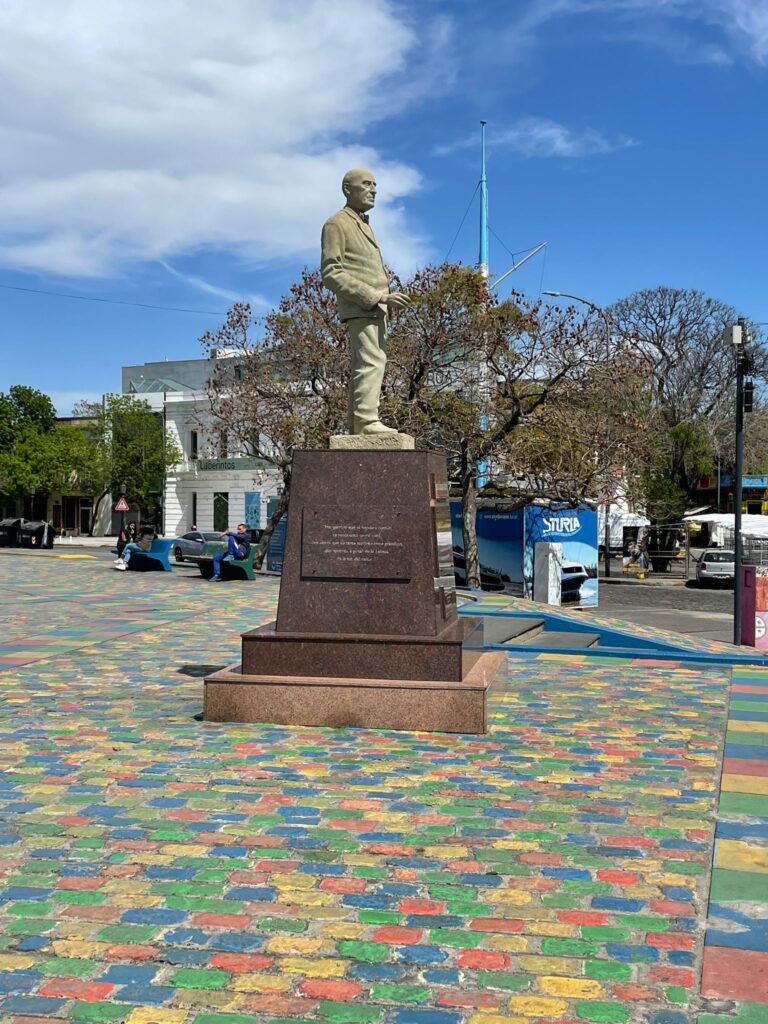
Explore the Colourful streets of El Caminito
El Caminito is the star attraction in La Boca. It attracts large numbers of tourists every single day. On the downside it attracts lots of those Instagram narcissists who will spend 45 minutes hogging the best photo spots to get 3,785 pictures of themselves posing in floaty dresses. Oh well, it’s still an awesome place where the positives outweigh the negatives.
Arguably the best photo spot in La Boca is outside the Cachafaz Caminito art cafe at the eastern entrance to El Caminito. Tourists were queuing to take turns in front of the entrance here on each occasion I walked past. Surely annoying for the cafe, but to be fair it is a very scenic spot. I tried taking a picture during a rare couple of seconds with no tourists stood in front of the cafe, only for it to be ruined by a huge sun streak across the image. Ah well, can’t win them all.
These days El Caminito is home to many places selling goods. I feel bad calling it a tourist trap, because it is pretty awesome, but yeah, most things sold here are targeted towards tourists.
Tourist spots are popular for good reason. Some places, like Villa General Belgrano or Iguazu Falls, attract tourists because they are great, even when taking challenges like the chaotic Iguazu border crossing into account. El Caminito is no different. Here are some examples of what you can buy in El Caminito:
- Alfajores and dulce de leche: Alfajores are small pastries made of honey, flour and nuts with dulce de leche in the middle. Dulce de leche is a caramel-style spread made by burning milk and sugar. Both are incredibly popular in Argentina and both are well worth sampling. The aforementioned Cachafez Caminito is one spot that sells these
- Wines: Is it even Argentina if you can’t grab some wine? Fortunately for you, there are many wine spots round here. Check out Almacen Porteno to get yourself a bottle or two round here
- Souvenirs: El Caminito is probably the epicentre of Argentina’s tourist tat industry. If you want to get postcards, fridge magnets, shirts, or anything else to remind you of your visit, then this is the place to be
- Tours: If you want to see more of Buenos Aires, book a Tango show, or even hop across the border to Uruguay, you can book a tour from here. Planet Baires have set up a stall in El Caminito offering all of the above
- Football merchandise: Unsurprisingly, given the area’s football heritage, items related to the beautiful game can also be found in El Caminito. Footballs, football shirts, caps, drinking cups and more can be found here. Most items have a Boca Juniors or Argentina national team theme, although some brave vendor decided to sell a River Plate ball as well. Boca Juniors and River Plate are bitter rivals who absolutely hate each other and violence is not uncommon when the two play, making this item a controversial one to sell here
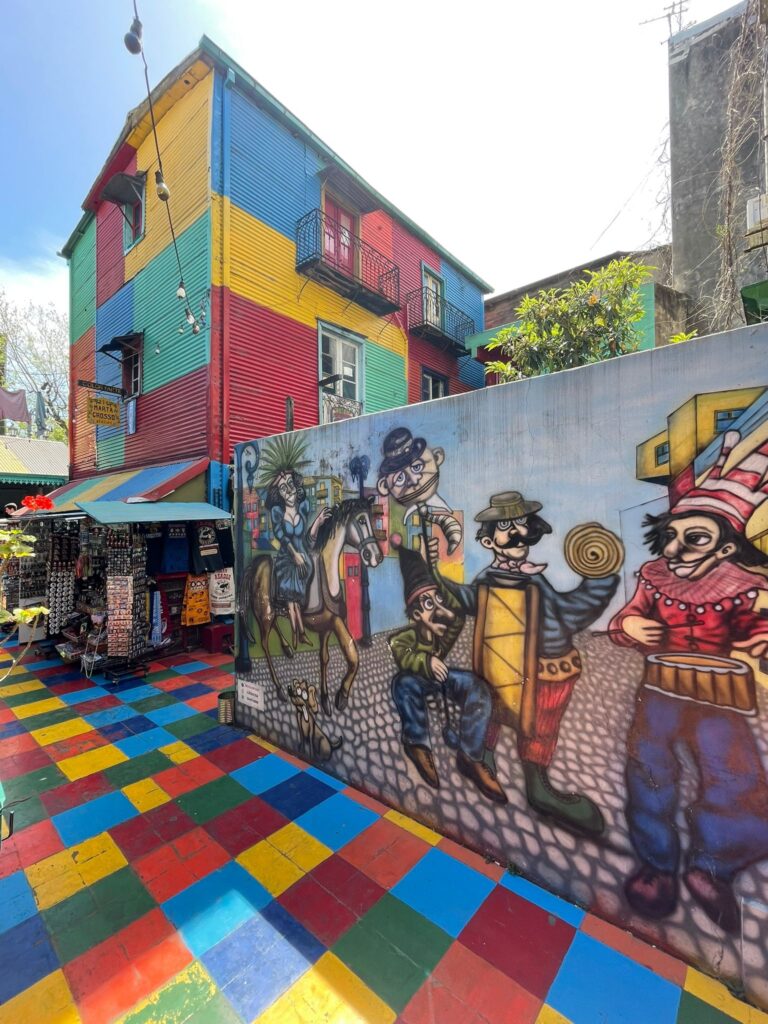
Watch Some Argentine Tango
When you think of Argentine culture, what do you think of? Perhaps two of the first things that come to mind are steak and tango dancing. The latter is an important part of the culture here, and you will often come across locals performing tango in restaurants, bars, and even on the streets of Buenos Aires.
El Caminito is no different. Just walk down the street and you will see restaurants with dancers performing. You can grab a bite to eat and watch the locals doing what they do best. Well worth it.
Tango is one of the best things to see in Buenos Aires.
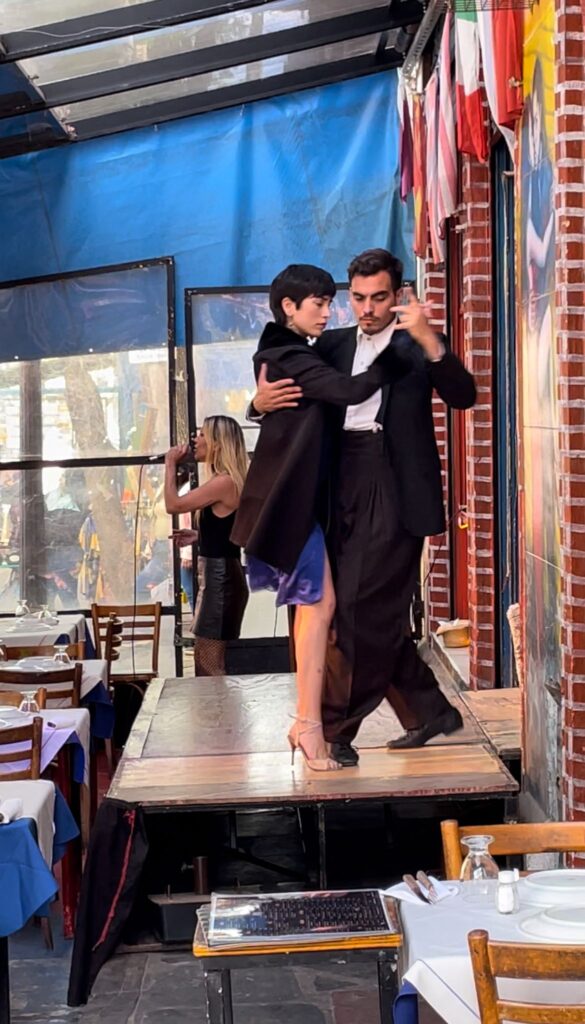
Eat Amazing Argentine Street Food
“La Boca” is Spanish for “the mouth”, and you will certainly be using yours in this tasty part of town. Argentina is the best place in the world to grab a cheap steak. Best of all, the quality is world class. That applies not just to steak in a fancy restaurant, but also meat on the street.
In fact I’m not exaggerating when I say the vacio sandwich I had at Resto Bar Las Gemelas (where they cook the meat on a parrilla in the street) was one of the best lunches I’ve ever had. And you can eat it either on one of their dining tables or on the go. This would be my personal recommendation for food in La Boca, but there certainly isn’t a shortage of local cuisine doing the rounds here.
Eating steak is an absolute must in any part of Argentina!
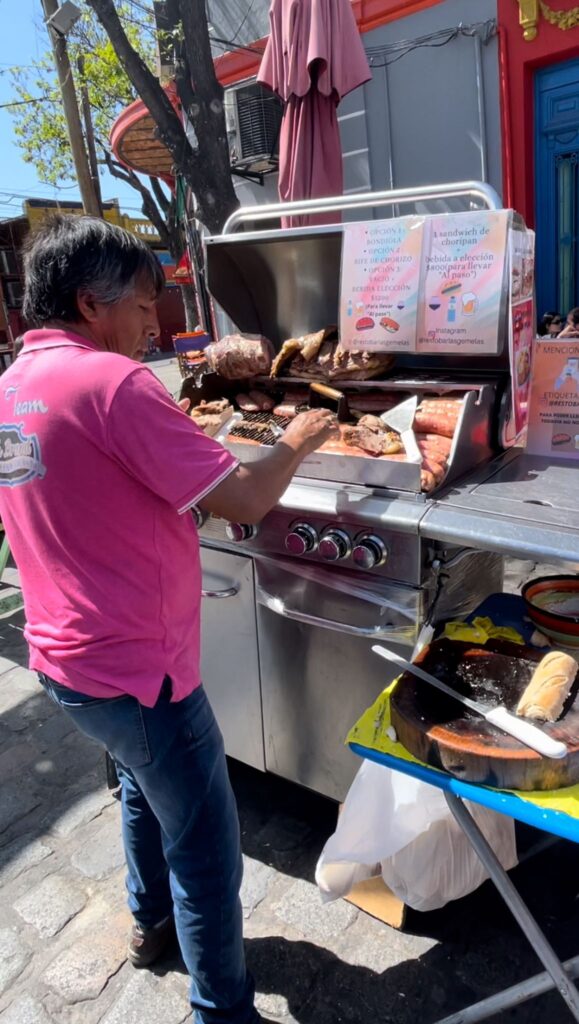
Visit Boca Juniors’ Football Stadium: La Bombonera
Last on my recommendations for the top things to do in La Boca is a visit to the iconic Alberto Jose Armando Stadium, most commonly known as La Bombonera, or “the chocolate box” due to its unusual shape. From an aerial view, it looks like the stadium has had one stand sliced off.
Boca Juniors are one of the most famous clubs in world football and it’s very hard to get tickets for a game without local contacts. You’re looking at a minimum of $100 to get into a game these days (if you’re lucky enough to find a contact who can get you a ticket). This rises to several hundred for the fierce derby game against hated rivals River Plate.
Boca represent the working classes of Buenos Aires, whereas River Plate are the club of the elites. The two are by far the most successful not just in the country, but in the whole of South America. And games between the two often result in violent clashes.
I was unsuccessful in my pursuit of Boca Juniors tickets, but whilst in La Boca I did at least manage to visit the Boca Juniors Museum (Museo de la Pasion Boquense). The entry fee is around $5.
There is no point listing the entrance fee in Argentine pesos because the local currency is volatile and shoots up every week. Click on the link to the official website, which I have just provided in the previous paragraph, to see current pricing in pesos. The museum has many displays on Boca’s proud history and successes as well as old shirts, memorabilia and images of famous players. The museum tour is self-guided, and ends with a trip to the club shop where you can purchase your own Boca Juniors gear.
The museum is a cheap activity and a chance to see one of South America’s most iconic clubs, although unfortunately you cannot see the pitch from the inside. I would certainly recommend this to any fellow football fans out there.
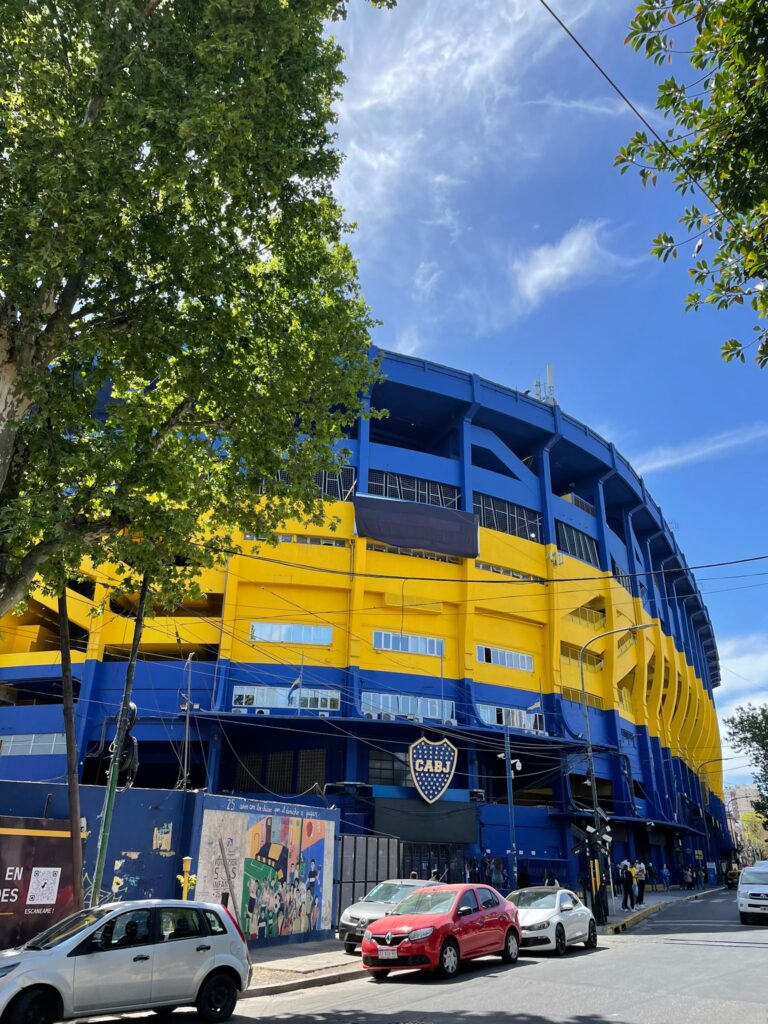
Is La Boca Safe?
In the past, La Boca was a complete no-go zone with crime absolutely rampant. Today, the situation has vastly improved, but that does not mean it is completely safe.
It is one of very few places that carry higher risk, in an otherwise very safe Argentina.
In the day time, if you stick to the area around El Caminito stretching between La Bombonera and the riverside, you should be fine. As with any touristy area, there will be opportunists looking to snatch your belongings if you let your guard down. However, this area is pretty safe and easy to traverse even on your own.
When the sun goes down, it is a very different story. The area is rife with muggings and you definitely don’t want to stay around here after the tourist spots close down for the night.
When leaving La Boca, I walked back through the San Telmo district towards my hostel in Monserrat. The walk took around an hour and whilst nothing bad happened to me, I would not recommend it, even during the daytime. The areas surrounding La Boca certainly had a bit of an edge to them. It wasn’t safe to get my phone out to check directions, therefore I had to duck into shops and restaurants if I needed to refer to maps at any point.
Around halfway through my journey back, it felt safer as I got back to San Telmo, however La Boca (excluding the touristy areas) is not an appropriate place to walk alone even at daytime.
Despite this, Buenos Aires is mostly very safe bar a few small pockets where you should take extra care. In fact, having travelled to almost every Latin American country, I would say Argentina is one of the safest Latin American countries to visit.
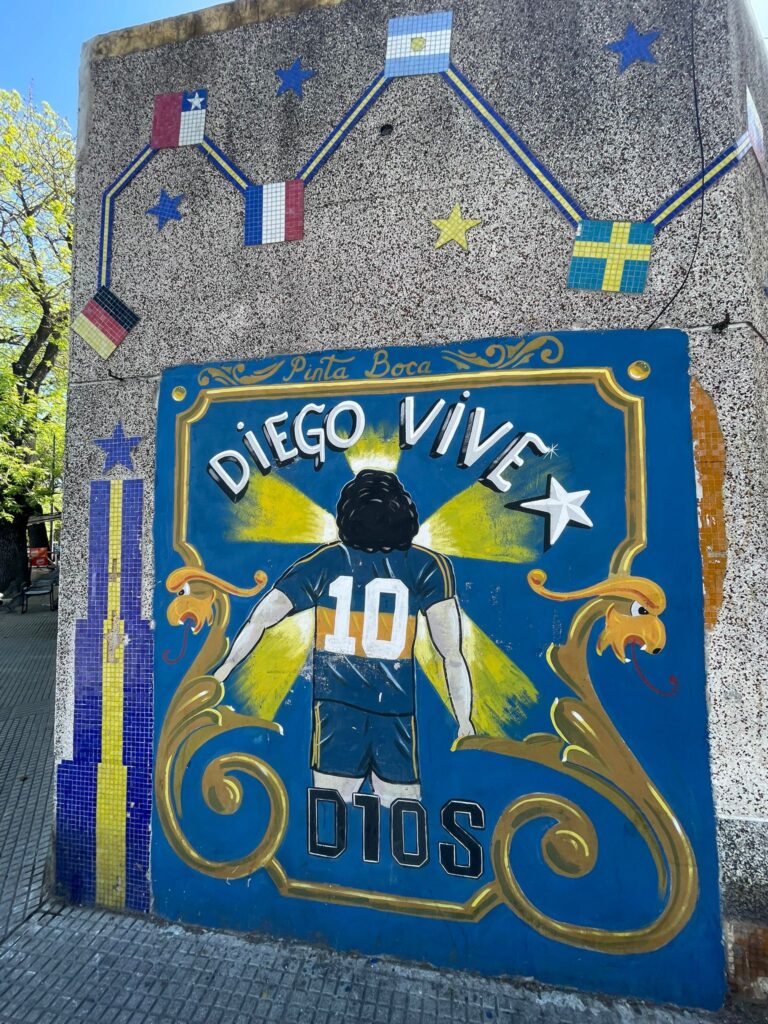
How to Get to La Boca
As mentioned above, I do not recommend walking to or from La Boca for safety reasons. The best way to get here is by taxi. Uber operates in Argentina, and a one-way journey should cost around $5 from the popular Palermo district (taking 30 minutes), half that from Monserrat (a 13-minute journey), and $2 from San Telmo (just 8 minutes away).
The other option is to go by bus. There are three main bus routes that stop in La Boca. Expect each route to take three times as long as a taxi.
Bus 64 heads down from Belgrano in northern Buenos Aires before going through Palermo and Monserrat. It eventually cuts through San Telmo and brushes past the outskirts of Puerto Madero before reaching La Boca.
Another option is bus 29 which takes a similar route. The main difference is that it cuts through San Nicolas instead of Monserrat. It also starts further north of Belgrano, in Olivos.
Lastly, bus 152 heads down from another part of Olivos, going through Belgrano and Palermo. The main difference with this route is that it goes between Monserrat/San Nicolas and Puerto Madero from Retiro, just passing the outskirts of Recoleta on the way down.
More Posts on Argentina
- The 17 Best Cities In South America To Visit In 2025
- The Safest Countries In South America In 2025: Ranked
- Best Countries In South America To Travel To: Ranked
- The Best Things To Do In Buenos Aires: A 3-Day Itinerary
- Buenos Aires Vs Rio De Janeiro: Which Is Better To Visit?
- What Are The Best South American Countries For First Timers?
- What Are The 10 Safest Cities In South America In 2025?
- The Ultimate 6 Month South America Itinerary On A Budget
- Planning The Perfect Day Trip To Colonia From Buenos Aires
- Is Argentina Safe For Tourists To Travel To?
- Salta To Asuncion By Bus (Clorinda/Jose Falcon Border)
- How To Get From Salta To Uyuni By Bus (La Quiaca/Villazon)
- Where To See Penguins In Argentina On A Budget: Punta Tombo
- One Day In Buenos Aires: The Perfect 24-Hour Itinerary
- A 2 Week Patagonia Itinerary: From Ushuaia To Bariloche
- Best Things To Do In Ushuaia: Don’t Miss Out On This Gem!
- Cafe Tortoni: What To Expect In The Famous Buenos Aires Cafe
- Iguazu Falls Border Crossing: How To Cross The Triple Frontier Between Argentina, Brazil And Paraguay
- The Ultimate Guide To Visiting Iguazu Falls (Argentina Side)
- Money In Argentina: How To Get The Best Rates In 2024
- A 3-Week Argentina Itinerary: From Mendoza To Buenos Aires
- What To Do In Villa General Belgrano?
- How To Order Steak In Argentina
- Top 5 Things To Do In La Boca, Buenos Aires
- Safest Latin American Countries To Visit In 2025
